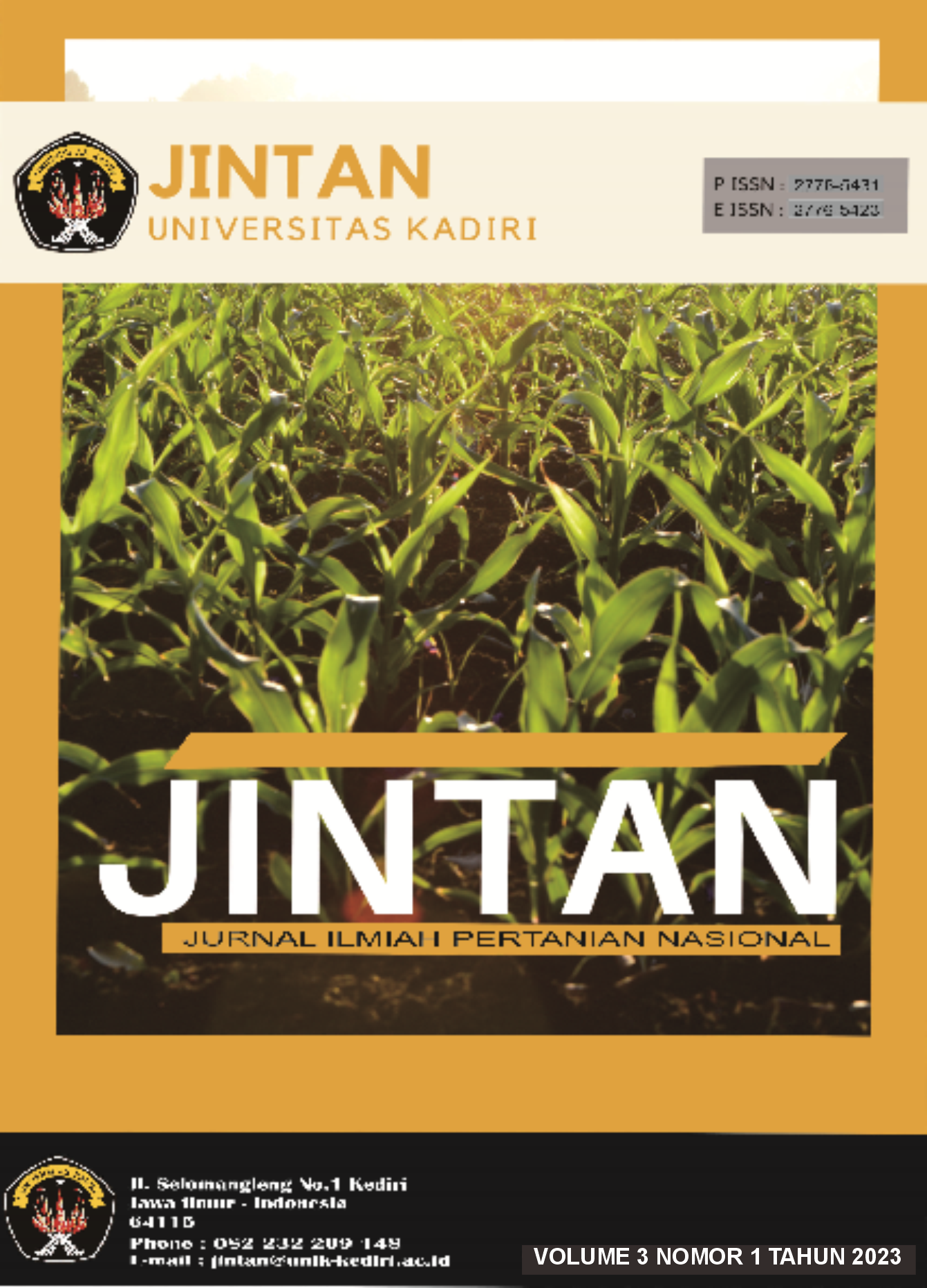Produksi dan Petumbuhan Terung Gelatik (Solanum melongena) atas Kombinasi Penyiangan dan Penggunaan Pupuk Cair dari Bonggol Pisang
DOI:
https://doi.org/10.30737/jintan.v3i1.3981Keywords:
Eggplant, LOF, WeedingAbstract
Eggplant (Solanum melongena) is classified as a favorite plant because of its high nutritional content and is widely used by some people. However, its productivity needs to be increased by using liquid organic fertilizer (LOF) and the weeding process. This study aimed to determine the effect of weeding frequency and dosage of banana weevil LOF on the growth and yield of eggplant. The method used in this research was a randomized block design with three repetitions. There were two factors: weeding with three treatments and LOF application doses with three treatments. Variables observed in this study were plant height (cm), number of leaves (strands), stem diameter (mm), leaf area (cm2), number of branches and number of flowers (buds), number of fruits per plant and per plot, fruit weight per plant and plot, and fruit diameter. Weeding treatment (20 and 40 days after planting) and LOF dose of 25 cc per plot had the highest value. Implementation of proper weeding and provision of the highest LOF dose can increase the growth and yield of eggplant.
Â
Terung gelatik (Solanum melongena) tergolong tanaman favorit sebagian masyarakat karena kandungan gizinya yang cukup tinggi. Namun, produktivitas tanaman terung perlu ditingkatkan, contohnya dengan aplikasi pupuk organik cair (POC) dan proses penyiangannya. Penelitian ini bertujuan untuk mengetahui pertumbuhan dan hasil tanaman terung gelatik (Solanum melongena) akibat pengaruh frekuensi penyiangan dan pemberian dosis pupuk organik cair (POC) dari bonggol pisang. Metode yang digunakan pada penelitian ini menggunakan rancangan acak kelompok dengan ulangan sebanyak 3 kali. Terdapat 2 faktor yaitu penyiangan dengan 3 perlakuan dan pemberian dosis POC dengan 3 perlakuan. Beberapa variabel yang diamati meliputi tinggi tanaman, diameter batang, jumlah daun, luas daun, banyak cabang, jumlah bunga, jumlah buah, berat dan diameter buah. Perlakuan penyiangan (20 dan 40) HST dan dosis POC 25 cc per plot memiliki nilai paling tinggi. Pelaksanaan penyiangan yang tepat dan pemberian poc yang paling tinggi dapat menjadikan pertumbuhan meningkat dan hasil tanaman terung gelatik.
References
Ali, A., & Inanosa, C, M. (2019). Pengaruh Waktu Penyiangan Gulma Terhadap Pertumbuhan Dan Produksi Tanaman Jagung Manis (Zea mays L. saccharata). 11, 28–38.
Ditasari, P., Kartika, Y., & Guritno Bambang. (2020). Pengaruh Dosis Pupuk Kandang Ayam Terhadap Pertumbuhan dan Hasil Dua Varietas Terung Gelatik ( Solanum melongena L .) The Effect of The Doses of Chicken Manure on The Growth and Yield of Two Gelatik Eggplant Varieties ( Solanum melongena L .). 8(2), 216–225.
Hakim, T., & Sains, F. (2019). RESPONSIF BOKASHI KOTORAN SAPI DAN POC BONGGOL PISANG TERHADAP PERTUMBUHAN DAN PRODUKSI BAWANG MERAH (Allium ascalonicum L.) Tharmizi. 22(2).
Harahap, R., & Pane Erwin & Gusmeizal. (2020). Jurnal Ilmiah Pertanian ( JIPERTA ) Effectivity of Cabbage Compost – banana weevil liquid organic fertilizer Combination For Long Bean Production. 2(September), 135–143.
Muldiana, S., & Rosdiana. (2017). RESPON TANAMAN TERONG (Solanum malongena L.) TERHADAP INTERVAL PEMBERIAN PUPUK ORGANIK CAIR DENGAN INTERVAL WAKTU YANG BERBEDA Sahri. March, 155–162.
Rohaeni, N., & Farida. (2019). No Title. 19(1), 1–8.
Safitri, A. D., Linda, R., & Rahmawati. (2017). Aplikasi Pupuk Organik Cair ( POC ) Kotoran Kambing Difermentasikan Dengan EM4 Terhadap Pertumbuhan Dan Produktivitas Tanaman Cabai Rawit ( Capsicum frutescents L .) Var . Bara. 6, 182–187.
Sahetapy, M. (2012). Respon Terong (Solanum melongena L.) Terhadap Perlakuan Dosis Pupuk Herbafarm. Jurnal Ilmiah Unklab, 16(1), 1–7.
Sahran, R. J., Pembengo, W., & Dude, S. (2018). Pengaruh Waktu Penyiangan dan Jenis Mulsa Organik Terhadap Pertumbuhan dan Hasil Tanaman Nilam ( Pogostemon cablin Benth). 7(1), 87–94.
Setyaningrum, H. D., & Saparinto, C. (2011). Panen Sayur secara Rutin di Lahan Sempit (Yudi (ed.); Edisi pert). Penebar Swadaya.
Sobari, E., & Fathurohman, F. (2017). EFEKTIVITAS PENYIANGAN TERHADAP HASIL TANAMAN WORTEL ( Daucus carota L .) LOKAL CIPANAS BOGOR. 2(1).
Tuhuteru, S., & Paling, S. (2019). Pembuatan Mikroorganisme Lokal Bonggol Pisang pada Kelompok Tani Tunas Harapan Distrik Walelagama , Jayawijaya , Papua ( Development Local Micro-Organism of Banana Weevil in Farmers Group of Tunas Harapan in Walelagama District , Jayawijaya , Papua ). 5(November), 188–194.
Yuliawati, & Samodro, Galih, S. (2018). Strategi Pengembangan Usahatani Sayuran Organik. 33(2), 169–179.
Downloads
Published
Issue
Section
License
Authors who publish in this journal agree to the following terms:
- Authors retain copyright and grant the journal right of first publication with the work simultaneously licensed under a Creative Commons Attribution License (https://creativecommons.org/licenses/by-nc-nd/4.0/) that allows others to share the work with an acknowledgment of the work's authorship and initial publication in this journal. Permitted third party reuse is defined by the Creative Commons Attribution-NonCommercial-NoDerivs (CC BY-NC-ND). This permission allows users to copy and distribute the Article, provided this is not done for commercial purposes and further does not permit distribution of the Article if it is changed or edited in any way, and provided the user gives appropriate credit (with a link to the formal publication through the relevant DOI), provides a link to the license, and that the licensor is not represented as endorsing the use made of the work.
- Authors are able to enter into separate, additional contractual arrangements for the non-exclusive distribution of the journal's published version of the work (e.g., post it to an institutional repository or publish it in a book), with an acknowledgment of its initial publication in this journal.
- Authors are permitted and encouraged to post their work online (e.g., in institutional repositories or on their website) prior to and during the submission process, as it can lead to productive exchanges, as well as earlier and greater citation of published work.
- For open-access publishing, authors have the right to share their articles in the same ways permitted to third parties under the relevant user license, as well as certain scholarly usage rights.
Deprecated: json_decode(): Passing null to parameter #1 ($json) of type string is deprecated in /home/ojs.unik-kediri.ac.id/public_html/plugins/generic/citations/CitationsPlugin.php on line 68




